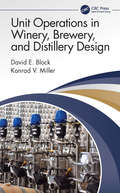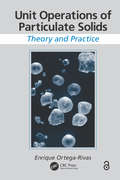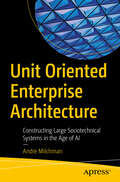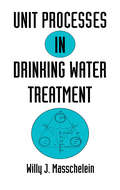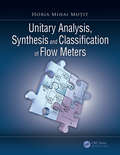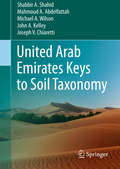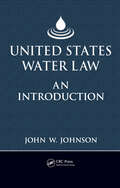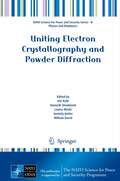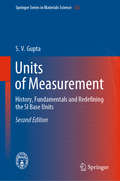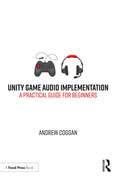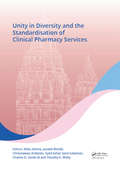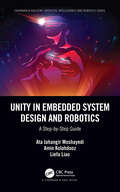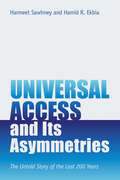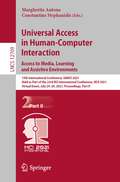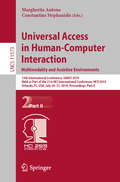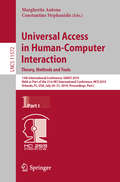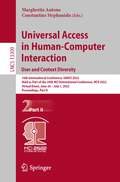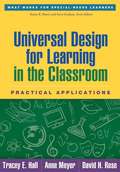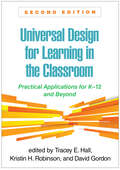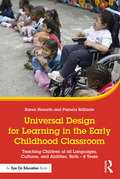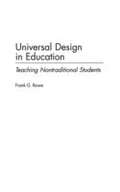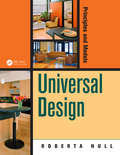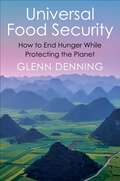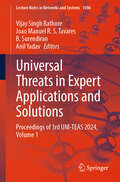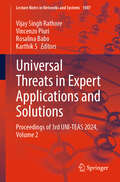- Table View
- List View
Unit Operations in Winery, Brewery, and Distillery Design
by David E. Block Konrad V. MillerUnit Operations in Winery, Brewery, and Distillery Design focuses on process design for wineries, breweries, and distilleries; and fills the need for a title that focuses on the challenges inherent to specifying and building alcoholic beverage production facilities. This text walks through the process flow of grapes to wine, grain to beer, and wine and beer to distilled spirits, with an emphasis on the underlying engineering principles, the equipment involved in these processes, and the selection and design of said equipment. Outlines the process flow of alcoholic beverage production Reviews process engineering fundamentals (mass & energy balances, fluid flow, materials receiving & preparation, heat exchange, fermentation, downstream processing, distillation, ageing, packaging, utilities, control systems, and plant layout) and their application to beverage plants Describes the idea of sanitary design and its application to plant operation and design Covers critical equipment parameters for purchasing, operating, and maintaining systems Shows how winery/brewery/distillery can influence product "style" and how "style" can dictate design Features examples of calculations derived from wineries designed by the authors, end of chapter problems, and integrative in-text problems that describe real-world issues and extend understanding Written for both engineers in the alcohol industry and non-engineers looking to understand facility design, this textbook is aimed at students, winemakers, brewers, distillers, and process engineers.
Unit Operations of Particulate Solids: Theory and Practice
by Enrique Ortega-RivasSuitable for practicing engineers and engineers in training, this book covers the most important operations involving particulate solids. Through clear explanations of theoretical principles and practical laboratory exercises, the text provides an understanding of the behavior of powders and pulverized systems. It also helps readers develop skills for operating, optimizing, and innovating particle processing technologies and machinery in order to carry out industrial operations. The author explores common bulk solids processing operations, including milling, agglomeration, fluidization, mixing, and solid-fluid separation.
Unit Oriented Enterprise Architecture: Constructing Large Sociotechnical Systems in the Age of AI
by Andre MilchmanExamine a new approach to Enterprise Architecture (EA) that challenges conventional practices and supports a transformative shift to address the demands of a rapidly evolving technological landscape. This book offers alternatives to traditional EA methods that often divide the enterprise into isolated business, application, data, and technology architectures, often resulting in disjointed operations and missed opportunities for innovation. By proposing an innovative, purpose-driven architectural style, this book emphasizes the need for a cohesive and adaptive framework that aligns all components of an enterprise with its strategic goals. Key concepts explored include the integration of social and technical elements in building large sociotechnical systems, the introduction of Unit Oriented Enterprise Architecture (UOEA) for modular and adaptable enterprise design, and the importance of Purpose Driven Design (PDD) in ensuring operational efficiency and strategic alignment. You’ll also gain insights into organizing software engineering in the cloud era, streamlining enterprise interactions, and embracing creative destruction to foster technological harmony. Unit Oriented Enterprise Architecture is your essential resource for system architects, organizational leaders, IT professionals, and students seeking to revolutionize their approach to enterprise architecture and position their organizations for success in the digital age. What You Will Learn Critically assess and dismantle outdated EA concepts to create a more adaptive and cohesive architectural framework. Explore how UOEA can enhance agility and adaptability, allowing your organization to respond more effectively to change. Organize and manage software development within cloud infrastructures, ensuring clarity, scalability, and alignment with your architectural framework. Who This Book Is For Primary Audience: Enterprise architects, organizational leaders, IT professionals; Secondary Audience: Consultants, advisors, and policymakers; Tertiary Audience: Students in system design and organizational studies, academic researchers
Unit Processes in Drinking Water Treatment
by Willy J. MasscheleinThis text offers information on the theory of major drinking water treatment processes and contains real-life practical examples. It aims to create guidelines for the design of unit processes that operate within an overall framework for water treatment plants.
Unitary Analysis, Synthesis, and Classification of Flow Meters
by Horia Mihai MoțitThis book is the first to present flow measurement as an independent branch of the measurement techniques, according to a new global and unitary approach for the measurement of fluid flow field, starting from finding its unitary fundamental bases. Furthermore, it elaborates the method of unitary analysis/synthesis and classification of compound gauging structures (CGS): the UASC – CGS method. These methods ensure, in a systematic and predictable way, both the analysis of the types of flow meters made until present (i.e. CGS) and the synthesis of new types of flowmeters. The book outlines new contributions in this field, including separately, for flow meters, and CGS: structural schemes and their unitary, unitary classification, unitary logical matrix, method of unitary analysis/synthesis and classification.
United Arab Emirates Keys to Soil Taxonomy
by Shabbir A. Shahid Mahmoud A. Abdelfattah Michael A. Wilson John A. Kelley Joseph V. ChiarettiCentral to human life and civilization, soils are an integral part of the physical and cultural environment. Although we may take them for granted, the rise and fall of civilizations is closely linked with the use and abuse of soil and water resources. It is therefore important to evaluate soils for their quality and link them to appropriate uses and services. This book provides information on soil classification and shows how to key out taxa relevant to UAE soils. The latest soil inventory of United Arab Emirates reveals that a rather uniform looking desert landscape has, in fact, a diversity of subsurface features. These features confirm the soil diversity in terms of classification, chemistry, physics, mineralogy, fertility, suitability for different uses and vulnerability to land degradation. United Arab Emirates Keys to Soil Taxonomy presents information for keying out the soils of the United Arab Emirates into separate classes and provides a guide to associated laboratory methods. The classification used predominantly is extracted from the 11th edition of the USDA-NRCS Keys to Soil Taxonomy, and sections relevant to the soils found in the UAE are included here. Primarily, this key is designed to fit the soil system of the United Arab Emirates. Information not found in the USDA key has been added, including criteria and classes for: 1) differentiating anhydritic soils from gypsic soils, 2) identifying "lithic" subgroups for Aquisalids and Haplosalids, 3) identifying "salidic" subgroups within the great groups of Gypsids, Calcids, Psamments, and Orthents, and 4) incorporation of phases for soil taxa. A subsurface diagnostic horizon and mineralogy class (anhydritic), not reported earlier in the world soil literature and, recently found in the UAE, has also been added to the book. The book also offers a mechanism for updating the current soil surveys, and will facilitate the correlation of soils from new surveys in the UAE. Additionally, it will help the international soil science community to converse about UAE soils, and facilitate comparison to soils of other regions. These linkages allow countries with similar mapping and classification procedures and similar soils to transfer agriculture technology without conducting long-term experiments under similar environmental conditions, especially for Gulf Cooperation Council countries (Bahrain, Kuwait, Qatar, Oman, and Saudi Arabia).
United States Water Law: An Introduction
by John W. JohnsonA Vital Explanation of Water Law and PolicyBecause demand for and access to quality water far exceeds the current supply, it is increasingly critical to understand the state and federal laws and policies that govern water rights. From farming, fishing, and biology to manufacturing, mine operation, and public water supply, water regulation affects a
Uniting Electron Crystallography and Powder Diffraction
by Anatoly Avilov Kenneth Shankland Louisa Meshi Ute Kolb William I.F DavidThe polycrystalline and nanocrystalline states play an increasingly important role in exploiting the properties of materials, encompassing applications as diverse as pharmaceuticals, catalysts, solar cells and energy storage. A knowledge of the three-dimensional atomic and molecular structure of materials is essential for understanding and controlling their properties, yet traditional single-crystal X-ray diffraction methods lose their power when only polycrystalline and nanocrystalline samples are available. It is here that powder diffraction and single-crystal electron diffraction techniques take over, substantially extending the range of applicability of the crystallographic principles of structure determination. This volume, a collection of teaching contributions presented at the Crystallographic Course in Erice in 2011, clearly describes the fundamentals and the state-of-the-art of powder diffraction and electron diffraction methods in materials characterisation, encompassing a diverse range of disciplines and materials stretching from archeometry to zeolites. As such, it is a comprehensive and valuable resource for those wishing to gain an understanding of the broad applicability of these two rapidly developing fields.
Units of Measurement: History, Fundamentals and Redefining the SI Base Units (Springer Series in Materials Science #122)
by S. V. GuptaThis book delivers a comprehensive overview of units of measurement. Beginning with a historical look at metrology in Ancient India, the book explains fundamental concepts in metrology such as basic, derived and dimensionless quantities, and introduces the concept of quantity calculus. It discusses and critically examines various three and four-dimensional systems of units used both presently and in the past, while explaining why only four base units are needed for a system of measurement. It discusses the Metre Convention as well as the creation of the International Bureau of Weights and Measures, and gives a detailed look at the evolution of the current SI base units of time, length, mass, electric current, temperature, intensity of illumination and substance.This updated second edition is extended with timely new chapters discussing past efforts to redefine the SI base units as well as the most recent 2019 redefinitions based entirely on the speed of light and other fundamental physical constants. Additionally, it provides biographical presentations of many of the historical figures behind commonly used units of measurements, such as Newton, Joule and Ohm, With its accessible and comprehensive treatment of the field, together with its unique presentation of the underlying history, this book is well suited to any student and researcher interested in the practical and historical aspects of the field of metrology.
Unity Game Audio Implementation: A Practical Guide for Beginners
by Andrew CogganUnity Game Audio Implementation offers a unique, practical, project-based approach to learning about aspects of Interactive Game Audio for those who have never used a game engine before and don’t want to learn computer programming right now. The book offers insight into the skills needed to design game-ready sounds in current Digital Audio Workstation (DAW) and shows how to implement these sounds within the Unity game engine. The reader will also learn about interactive music and how to set this up to respond to a variety of events in the game, with the option of adding in their own story and dialogue. All the information is presented in a practical working context from an established Game Audio Sound Designer with AAA games experience. The chapters are accompanied by several game levels teaching all about the techniques and theories before offering instructive steps for how to put them into action. After completing the practical tasks in this book, not only will the reader create an interactive soundscape for a multilevel playable game featuring all their own audio, they will also receive tips on how to use their finished project in support of an application for Video Game Sound Designer jobs.
Unity in Diversity and the Standardisation of Clinical Pharmacy Services: Proceedings of the 17th Asian Conference on Clinical Pharmacy (ACCP 2017), July 28-30, 2017, Yogyakarta, Indonesia
by Elida Zairina, Junaidi Khotib, Chrismawan Ardianto, Syed Azhar Syed Sulaiman, Charles D. Sands III and Timothy E. WeltyUnity in Diversity and the Standardisation of Clinical Pharmacy Services represents the proceedings of the 17th Asian Conference on Clinical Pharmacy (ACCP 2017), held 28—30 July 2017 in Yogyakarta, Indonesia. The primary aim of ACCP 2017 was to bring together experts from all fields of clinical pharmacy to facilitate the discussion and exchange of research ideas and results. The conference provided a forum for the dissemination of knowledge and exchange of experiences. As such, it brought together clinical pharmacy scholars, pharmacy practitioners, policy makers and stakeholders from all areas of pharmacy society and all regions of the world to share their research, knowledge, experiences, concepts, examples of good practice, and critical analysis with their international peers. This year also marks the celebration of 20 years of ACCP. Central themes of the conference and contributed papers were Clinical Pharmacy, Social and Administrative Pharmacy, Pharmacy Education, Pharmacoeconomics, Pharmacoepidemiology, Complementary and Alternative Medicine (CAM) and a number of related topics in the field of Pharmacy.
Unity in Embedded System Design and Robotics: A Step-by-Step Guide (Chapman & Hall/CRC Artificial Intelligence and Robotics Series)
by Ata Jahangir Moshayedi Amin Kolahdooz Liefa LiaoThe first book of its kind, Unity in Embedded System Design and Robotics provides a step-by-step guide to Unity for embedded system design and robotics. It is an open gateway for anyone who wants to learn Unity through real projects and examples as well as a particularly useful aid for both professionals and students in the fields of embedded system design and robotics. Each chapter contains a unique project. The user is guided through the different windows and sections of Unity every step of the way. The book also includes projects that connect Unity to Arduino and Raspberry Pi, which will help readers better understand various Unity applications in the real world.
Universal Access and Its Asymmetries: The Untold Story of the Last 200 Years (Information Policy)
by Hamid R. Ekbia Harmeet SawhneyA framework for understanding the totality of costs and benefits of universal access that will foster honest appraisal and guide the development of good policies.Universal access—the idea that certain technologies and services should be extended to all regardless of geography or ability to pay—evokes ideals of democracy and equality that must be reconciled with the realities on the ground. The COVID-19 pandemic raised awareness of the need for access to high-speed internet service in the United States, but this is just the latest in a long history of debates about what should be made available and to whom. Rural mail delivery, electrification, telephone service, public schooling, and library access each raised the same questions as today&’s debates about health care and broadband. What types of services should be universally available? Who benefits from extending these services? And who bears the cost? Stepping beyond humanitarian arguments to conduct a clear-eyed, diagnostic analysis, this book offers some surprising conclusions. While the conventional approach to universal access looks primarily at the costs to the system and the benefits to individuals, Harmeet Sawhney and Hamid Ekbia provide a holistic perspective that also accounts for costs to individuals and benefits for systems. With a comparative approach across multiple cases, Universal Access and Its Asymmetries is an essential exploration of the history, costs, and benefits of providing universal access to technologies and services. With a fresh perspective, it overturns common assumptions and offers a foundation for making decisions about how to extend service—and how to pay for it.
Universal Access in Human-Computer Interaction. Access to Media, Learning and Assistive Environments: 15th International Conference, UAHCI 2021, Held as Part of the 23rd HCI International Conference, HCII 2021, Virtual Event, July 24–29, 2021, Proceedings, Part II (Lecture Notes in Computer Science #12769)
by Margherita Antona Constantine StephanidisThis two-volume set constitutes the proceedings of the 15th International Conference on Universal Access in Human-Computer Interaction, UAHCI 2021, held as part of the 23rd International Conference, HCI International 2021, held as a virtual event, in July 2021. The total of 1276 papers and 241 posters included in the 36 HCII 2021 proceedings volumes was carefully reviewed and selected from 5222 submissions. UAHCI 2021 includes a total of 84 regular papers; they focus on topics related to universal access methods, techniques and practices, studies on accessibility, design for all, usability, UX and technology acceptance, emotion and behavior recognition for universal access, accessible media, access to learning and education, as well universal access to virtual and intelligent assistive environments.
Universal Access in Human-Computer Interaction. Multimodality and Assistive Environments: 13th International Conference, UAHCI 2019, Held as Part of the 21st HCI International Conference, HCII 2019, Orlando, FL, USA, July 26–31, 2019, Proceedings, Part II (Lecture Notes in Computer Science #11573)
by Margherita Antona Constantine StephanidisThis two-volume set constitutes the proceedings of the 13th International Conference on Universal Access in Human-Computer Interaction, UAHCI 2019, held as part of the 21st International Conference, HCI International 2019, which took place in Orlando, FL, USA, in July 2019.The total of 1274 papers and 209 posters included in the 35 HCII 2019 proceedings volumes was carefully reviewed and selected from 5029 submissions.UAHCI 2019 includes a total of 95 regular papers; they were organized in topical sections named: universal access theory, methods and tools; novel approaches to accessibility; universal access to learning and education; virtual and augmented reality in universal access; cognitive and learning disabilities; multimodal interaction; and assistive environments.
Universal Access in Human-Computer Interaction. Theory, Methods and Tools: 13th International Conference, UAHCI 2019, Held as Part of the 21st HCI International Conference, HCII 2019, Orlando, FL, USA, July 26–31, 2019, Proceedings, Part I (Lecture Notes in Computer Science #11572)
by Margherita Antona Constantine StephanidisThis two-volume set constitutes the proceedings of the 13th International Conference on Universal Access in Human-Computer Interaction, UAHCI 2019, held as part of the 21st International Conference, HCI International 2019, which took place in Orlando, FL, USA, in July 2019. The total of 1274 papers and 209 posters included in the 35 HCII 2019 proceedings volumes was carefully reviewed and selected from 5029 submissions. UAHCI 2019 includes a total of 95 regular papers; they were organized in topical sections named: universal access theory, methods and tools; novel approaches to accessibility; universal access to learning and education; virtual and augmented reality in universal access; cognitive and learning disabilities; multimodal interaction; and assistive environments.
Universal Access in Human-Computer Interaction. User and Context Diversity: 16th International Conference, UAHCI 2022, Held as Part of the 24th HCI International Conference, HCII 2022, Virtual Event, June 26 – July 1, 2022, Proceedings, Part II (Lecture Notes in Computer Science #13309)
by Margherita Antona Constantine StephanidisThis two-volume set constitutes the refereed proceedings of the 16th International Conference on Universal Access in Human-Computer Interaction, UAHCI 2022, held as part of the 24th International Conference, HCI International 2022, held as a virtual event, in June-July 2022. A total of 1271 papers and 275 posters included in the 39 HCII 2022 proceedings volumes. UAHCI 2022 includes a total of 73 papers; they focus on topics related to universal access methods, techniques and practices, studies on accessibility, design for all, usability, UX and technology acceptance, emotion and behavior recognition for universal access, accessible media, access to learning and education, as well universal access to virtual and intelligent assistive environments.
Universal Design for Learning in the Classroom
by Anne Meyer Tracey HallClearly written and well organized, this book shows how to apply the principles of universal design for learning (UDL) across all subject areas and grade levels. The editors and contributors describe practical ways to develop classroom goals, assessments, materials, and methods that use UDL to meet the needs of all learners. Specific teaching ideas are presented for reading, writing, science, mathematics, history, and the arts, including detailed examples and troubleshooting tips. Particular attention is given to how UDL can inform effective, innovative uses of technology in the inclusive classroom.
Universal Design for Learning in the Classroom: Practical Applications for K-12 and Beyond
by David Gordon Tracey E. Hall Kristin H. RobinsonThe Universal Design for Learning (UDL) framework has grown from its origins in special education to being widely used to support all students, making the fully rewritten second edition of this indispensable guide more relevant than ever. Filled with practical, vivid examples and tips, the book demonstrates the power of UDL when applied to particular content areas. Specific teaching ideas are presented for literacy, STEM, project-based learning, career and technical education, and the arts. The editors and contributors describe practical ways to create thriving learning environments that use UDL to meet diverse learners' needs. New to This Edition *Entirely new content. *Coverage expanded from elementary and middle grades to secondary and beyond. *Innovative approaches embracing the growth of UDL and the ubiquity of digital technologies in today&’s classrooms. *Spotlight on issues of equity and inclusion. *Chapters on antiracism, social–emotional learning, career and technical education, journey mapping, and curriculum design. *Compelling discussions of advances in UDL principles and research directions.
Universal Design for Learning in the Early Childhood Classroom: Teaching Children of all Languages, Cultures, and Abilities, Birth – 8 Years
by Karen Nemeth Pamela BrillanteUniversal Design for Learning in the Early Childhood Classroom focuses on proactively designing PreK through Grade 3 classroom environments, instruction, and assessments that are flexible enough to ensure that teachers can accommodate the needs of all the students in their classrooms. Typically developing students, gifted students, students who are impacted by poverty, children who speak multiple languages or have a home language that is different than the classroom language, and students with identified or potential developmental or learning disabilities are all covered within this highly practical, easy-to-use guide to UDL in the early years.
Universal Design in Education: Teaching Nontraditional Students
by Frank G. BoweIntended to be used as a handbook, this volume provides teachers of all grades and programs with ways of designing and delivering instruction that responds to the needs of diverse students, including those with disabilities, different learning styles, scheduling difficulties, and of ethnic and racial minority cultures. Bowe (special education, Hofstra U. ) outlines seven educational principles basic to the concept of universal design and addresses web site accessibility.
Universal Design: Principles and Models
by Roberta NullAs the baby boom generation ages, it is crucial that designers understand all they can about bringing this group, as well as all others, design that will offer function, aesthetics, and quality of life. Full of examples and illustrated with pictures of good design, Universal Design: Principles and Models details how the principles of universal desi
Universal Food Security: How to End Hunger While Protecting the Planet
by Glenn DenningWhat would it take to achieve a genuinely food-secure world—one without hunger or malnutrition, where everyone gets to consume the right quantity and quality of food to live a healthy, active, and productive life? Bringing about such a future requires transforming how our food is grown, managed, and distributed. From production to consumption, food systems must be sustainable, halting environmental degradation and even repairing the damage we have previously done.This book provides an accessible guide to making healthy diets from sustainable food systems available to all. Glenn Denning bridges the divisive worlds of science, policy, and practice. He synthesizes the most relevant literature and shares personal perspectives and insights gained over four decades working in more than fifty countries, coupled with the real-world experience of hundreds of leading experts. Universal Food Security lays out key priorities—sustainable intensification, market infrastructure, postharvest stewardship, healthy diets, and social protection—and presents how to achieve food systems transformation.Denning identifies the education and development of practitioner-leaders as the critical trigger of change. Universal Food Security informs and inspires those leaders—acting on their own and with others through institutions—to achieve a food-secure world. This book is an ideal handbook for students and practitioners looking to transform our food systems at all levels.
Universal Threats in Expert Applications and Solutions: Proceedings of 3rd UNI-TEAS 2024, Volume 1 (Lecture Notes in Networks and Systems #1006)
by Vijay Singh Rathore Joao Manuel R. S. Tavares B. Surendiran Anil YadavThis book presents high-quality, peer-reviewed papers from 3rd International Conference on “Universal Threats in Expert Applications and Solutions" (UNI-TEAS 2024), jointly being organized by IES University, Bhopal, and Shree KKarni Universe College, Jaipur, in association with CSI Jaipur Chapter and Jaipur ACM Professional Chapter during January 6–9, 2024. The book is a collection of innovative ideas from researchers, scientists, academicians, industry professionals, and students. The book covers a variety of topics, such as expert applications and artificial intelligence/machine learning; advance web technologies such as IoT, big data, cloud computing in expert applications; information and cyber security threats and solutions, multimedia applications in forensics, security and intelligence; advancements in app development; management practices for expert applications; and social and ethical aspects in expert applications through applied sciences.
Universal Threats in Expert Applications and Solutions: Proceedings of 3rd UNI-TEAS 2024, Volume 2 (Lecture Notes in Networks and Systems #1007)
by Vincenzo Piuri Rosalina Babo Vijay Singh Rathore Karthik SThe book presents high-quality, peer-reviewed papers from 3rd International Conference on “Universal Threats in Expert Applications and Solutions" (UNI-TEAS 2024), jointly being organized by IES University, Bhopal, and Shree KKarni Universe College, Jaipur, in association with CSI Jaipur Chapter and Jaipur ACM Professional Chapter during January 6–9, 2024. The book is a collection of innovative ideas from researchers, scientists, academicians, industry professionals, and students. The book covers a variety of topics, such as expert applications and artificial intelligence/machine learning; advanced web technologies such as IoT, big data, and cloud computing in expert applications; information and cyber security threats and solutions, multimedia applications in forensics, security and intelligence; advancements in app development; management practices for expert applications; and social and ethical aspects in expert applications through applied sciences.
